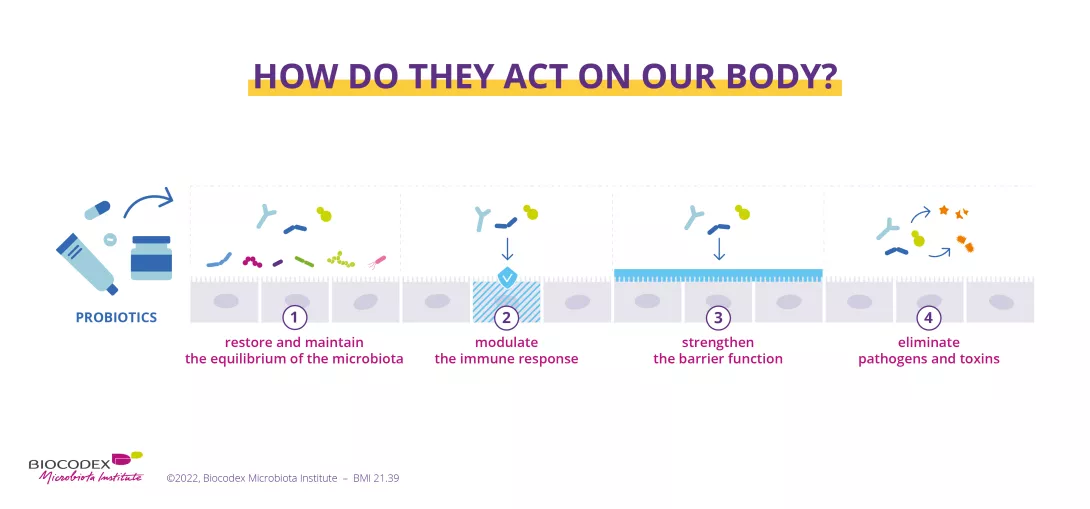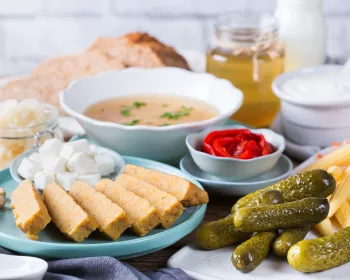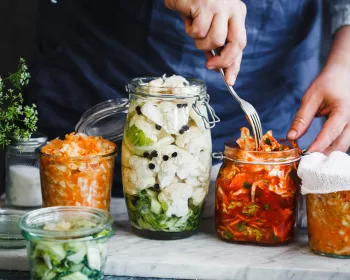What is the difference between prebiotics, probiotics and postbiotics?
Prebiotics, probiotics, postbiotics... Behind these confusing terms actually lies an exciting universe related to our health. These "biotics" are the discreet little hands working behind the scenes to take care of our precious intestinal microbiota. Ready to lift the veil on their unique roles and fundamental differences? In this article, we will unravel the threads of this microscopic web to allow you to tame these unsuspected allies of well-being. Let's explore together this fascinating ecosystem that resides in each of us!
- Learn all about microbiota
- Microbiota and related conditions
- Act on your microbiota
- Publications
- About the Institute
Healthcare professionals section
Find here your dedicated section
Sources
This article is based on scientific information
About this article
Author
Introduction
We're about to dive into the fascinating world of "biotics." Now, you might be thinking, "What in the world are 'biotics'?" Well, it all goes back to an ancient Greek word, "bíos," which simply means "life." From that root word, we get terms like probiotics, prebiotics, postbiotics, synbiotics. These aren't just fancy scientific names – they're like the different parts that make up a lively neighborhood, each playing a unique role in keeping things running smoothly.
Imagine you're the new resident on the block, and a friendly neighbor offers to show you around, pointing out all the key people and places that make the community tick. That's what we're doing here – getting a local's tour of the "biotics" neighborhood inside your body.

Probiotics: your body's helpers
In our city of health, probiotics are like our visiting beneficial friends – live microorganisms that take up residence within us and contribute to our well-being. As defined by the World Health Organization (WHO) and the International Scientific Association for Probiotics and Prebiotics (ISAPP), probiotics are "live microorganisms which, when administered in adequate amounts, confer a health benefit on the host." 1
In simpler terms, they are beneficial microbes such as bacteria, yeast, … that support our overall well-being. Probiotics contribute to our health in various ways, such as:
- promoting a balanced microbiome 2
- inhibiting the growth of pathogens inside the human body 3
- improvement in barrier and metabolic functions of targeted organs 4, 5, 6
- supporting immune function 7
- and modulation of diverse signaling and metabolic pathways 8
One widespread misconception is that all fermented foods, such as yogurt, kefir, or kombucha, are inherently probiotic. 9 While fermentation can introduce beneficial bacteria, not all fermented products contain live, probiotic strains that meet the criteria set forth by health authorities. 10 However, some fermented foods are fermented using a microbe proven to be a probiotic, or have been supplemented with probiotics in sufficient quantities to offer health benefits.
It's essential to carefully read labels and rely on reputable sources to ensure you're consuming products with scientifically and clinically validated probiotic cultures. Additionally, some assume that probiotics are a one-size-fits-all solution, but different strains can have varying effects on different individuals and health conditions. 1, 11 Consulting with healthcare professionals and following evidence-based guidelines is crucial for optimizing the benefits of probiotics based on your unique needs and circumstances.

If you want to learn more about probiotics, you can read our dedicated section here:
Probiotics

Prebiotics: food for the good guys – but not only!
Prebiotics are defined as "a substrate that is selectively utilized by host microorganisms conferring a health benefit." 12, 13 Unlike probiotics, prebiotics themselves are not live microbes but rather serve as fuel for the existing beneficial bacteria in our microbiome. It's a common oversimplification to describe prebiotics as "food for probiotics."
While prebiotics do support probiotic growth, their beneficial effects stem from the activity of the resident gut microbiota, which metabolize these compounds, indirectly conferring physiological advantages to the host – us! Moreover, not all dietary fibers are prebiotics, and not all prebiotics are fibers. 14 This distinction is often overlooked, leading to misconceptions about their definitions and functions.
Imagine prebiotics as favorite restaurants for your helpful bacteria. Foods like bananas, onions, and garlic are rich in substances such as inulin and galacto-oligosaccharides (GOS) that act as prebiotics. When your beneficial bacteria dine on these foods, they can increase the production of molecules, i.e. metabolites, such as short-chain fatty acids (sidenote: Short chain fatty acids (SCFA) Short chain fatty acids (SCFA) are a source of energy (fuel) for an individual’s cells. They interact with the immune system and are involved in communication between the intestine and the brain. Silva YP, Bernardi A, Frozza RL. The Role of Short-Chain Fatty Acids From Gut Microbiota in Gut-Brain Communication. Front Endocrinol (Lausanne). 2020;11:25. ) acetate, propionate, and butyrate which in turn can improve your health. 15
Beyond supporting gut health, prebiotics have been linked to re-balancing the microbiota for better defense against pathogens, 16 weight management, 17 better mineral absorption, 18 etc. Their benefits extend beyond just the gut. 19
We have also prepared a dedicated section about prebiotics and their health benefits here:
Prebiotics: what you need to know

Postbiotics: gifts from the microbes
After probiotics have completed their visit of the city, they leave behind gifts known as postbiotics. These are like the products and services that businesses in a city provide after taking in raw materials. Postbiotics include beneficial substances like vitamins and (sidenote: Short chain fatty acids (SCFA) Short chain fatty acids (SCFA) are a source of energy (fuel) for an individual’s cells. They interact with the immune system and are involved in communication between the intestine and the brain. Silva YP, Bernardi A, Frozza RL. The Role of Short-Chain Fatty Acids From Gut Microbiota in Gut-Brain Communication. Front Endocrinol (Lausanne). 2020;11:25. ) . They're the rewards your body gets from the probiotics' hard work.
This definition was revised many times, and the Scientific Community have now reached a consensus: “postbiotic is a preparation of inanimate microorganisms and/or their components that confers a health benefit on the host.” This means that postbiotics are not just the “re-purposed” waste of the probiotics (or their end-products), but they are also the “dead” probiotics themselves and fragment components! 20
Such as probiotics, postbiotics have been shown to strengthen the barrier function, reduce inflammation, and exhibit antimicrobial activity against pathogens, thereby promoting overall health. 21 Their beneficial properties also extend beyond the gut with benefits for skin and vaginal health and potentially addressing skin and vaginal conditions. 22, 23
You may have heard additional names such as Parabiotics, Paraprobiotic or Proteobiotics. Indeed, some researchers have tried to define further the different elements or body parts of the postbiotic component, meaning dead cells, components of the cells and the metabolites produced by those microbial cells.
- While Parabiotics and Paraprobiotic are synonymous, they’re used to describe the inactivated microbial cells, either intact or broken; think of them as the "ghosts" of those helpful microbes still being able to lend a hand. 24
- On the other hand, Proteobiotics are natural metabolites produced by the probiotic during fermentation. 25, 26
However, there is no consensus agreement on these possible definitions, and they all fall under the ISAPP definition of Postbiotic. 20

Synbiotics in action and psychobiotics curious case
Synbiotics are like community projects that bring everyone together for a common goal. 27 They combine probiotics and prebiotics in a single product, ensuring that the good bacteria not only have a place to live but also plenty of their favorite food right from the start. This combination can be found in some yogurts and dietary supplements, designed to work together to provide an even greater health benefit.
On the other hand, Psychobiotics are a whole new category of probiotics and prebiotics that can actually benefit your mental health when consumed properly. 28 They work through something called the gut-brain axis. Basically, your gut and brain are physically connected and are in constant communication. The microbes living in your intestines can send signals to your brain that impact your mood, cognition, and even behaviors.
Researchers are really excited about the potential of psychobiotics. Early studies show they may help prevent or improve conditions like neurodegenerative diseases like Alzheimer's or Parkinson's. Some evidence even suggests psychobiotics could play a therapeutic role in treating psychiatric disorders like depression or anxiety. 29
You can find out more about the interaction between the gut and the brain here:
What role does the microbiota play in the gut-brain axis?
What about antibiotics?
Finally, it's essential to differentiate antibiotics from the other "biotics." While antibiotics are crucial life-saving medications for treating bacterial infections, their indiscriminate or excessive use can severely disrupt the delicate balance of the microbiome, potentially causing unintended and far-reaching consequences. 30, 31 These powerful drugs don't discriminate between harmful and beneficial bacteria, which means they can decimate the vital microbial populations that promote health and immunity.
Antibiotic resistance
Furthermore, the overuse of antibiotics contributes to the alarming rise of antibiotic-resistant superbugs, posing a significant global health threat. 30 Therefore, it's imperative to use antibiotics judiciously and only when absolutely necessary, under the guidance of healthcare professionals.
Maintaining a healthy, diverse microbiome through probiotics, prebiotics, and other "biotics" can help counteract some of the collateral damage caused by antibiotics and support overall well-being.
You can find here a dedicated section about the effects of antibiotics on the microbiota and on your health:
Antibiotics: what impact on the microbiota and on our health?
Each year, since 2015, the WHO organizes the World AMR Awareness Week (WAAW), which aims to increase awareness of global antimicrobial resistance.
Antimicrobial resistance occurs when bacteria, viruses, parasites and fungi change over time and no longer respond to medicines. As a result of drug resistance, antibiotics and other antimicrobial medicines become ineffective and infections become increasingly difficult or impossible to treat, increasing the risk of disease spread, severe illness and death.
Held on 18-24 November, this campaign encourages the general public, healthcare professionals and decision-makers to use antibiotics, antivirals, antifungals and antiparasitics carefully, to prevent the further emergence of antimicrobial resistance.
Recommended by our community

"Very useful" - @Konstantinos Paloumpis (From Biocodex Microbiota Institute on LinkedIn)


















